
OPTIMOD-PC
OPERATION
3-17
While this is an easy solution that does not require your automation system to tell
the 1101 when to recall presets, it is not ideal because there are some short-term
loudness events, like sibilance, applause, and whistles, that can be annoying to audi-
ences. You can use the Speech-Mode B4 and B5 compressor threshold controls to
accomplish the same goal.
Another loudness control strategy is this: Instead of using two presets with and
without loudness control (as described above), you can create presets with different
settings of the
L
OUDNESS
A
TTACK
control (and possibly different settings of the
L
OUDNESS
T
HRESHOLD
control as well). Try a slow attack (50% or below) for dramatic
programming and a faster attack (70%) for commercial breaks. This will maintain
some automatic loudness control for dramatic programming while controlling the
loudness of commercial breaks more rigorously.
Note that the Loudness Controller operates with reference to an absolute subjective
loudness threshold that does not adapt to program context. This means that if there
is a transition between very quiet program material (like footfalls through rustling
leaves) and a commercial, the commercial may
still
seem offensively loud even
though the Loudness Controller is controlling its loudness correctly with reference to
other sounds that reach full-scale loudness. Philosophically, this is inevitable; the
Loudness Controller cannot reduce the level of the commercial to the level of rus-
tling leaves without destroying the effectiveness of the commercial and angering
the sponsor!
BS.1770 Safety Limiter
Following the CBS Loudness Controller is a BS.1770 Safety Limiter (first implemented
in v3.1 software) that will prevent a BS.1770-2 loudness meter with 10-second inte-
gration time from indicating higher than the setting of the
BS.1770
T
HRESHOLD
con-
trol, which is found in the
M
ULTIBAND
page. The
BS.1770
T
HRESHOLD
control is part of
the on-air processing preset, so if you change the setting of this control from its de-
fault value (which we recommend doing), you should save your work as a User Pre-
set.
Because some organizations will disqualify an automatic loudness controller if it
causes a BS.1770 meter to read higher than a specified threshold, all of the “TV” fac-
tory presets have this controller active with the
BS.1770
T
HRESHOLD
control set to
0 LK. If your organization does not have a strict policy about processing for the
BS.1770 meter, we recommend that you edit your preferred preset by setting this
control anywhere from
+2
to
O
FF
and then saving the result as a User Preset
.
The BS.1770 safety limiter receives the output of the CBS Loudness Con-
troller and drives the final peak limiters. The total amount of loudness
control-induced gain reduction is the sum of the gain reduction produced
by the CBS Loudness Controller and the gain reduction produced by the
BS.1770 safety limiter. The gain reduction produced by the BS.1770 safety
limiter changes slowly, seldom exceeds 2 dB, and is indicated by the cyan
section of the
L
OUDNESS
GR
meter. The gain reduction produced by the
CBS Loudness Controller may change slowly or quickly (depending on the
nature of the program material), appears in blue, and rides on top of the
BS.1770 gain reduction. The peak reading of the meter thus shows the
total gain reduction that both controllers produce.
Содержание Optimod-PC 1101
Страница 4: ......
Страница 14: ......
Страница 121: ...OPTIMOD PC OPERATION 3 1 Section 3 Operation Figure 3 1 The OPTIMOD PC Control Application...
Страница 192: ...3 72 OPERATION ORBAN MODEL 1101...
Страница 204: ......
Страница 210: ......
Страница 212: ...5 2 UNINSTALLATION ORBAN MODEL 1101...
Страница 236: ......
















































